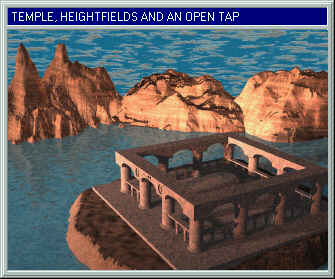

|
|
|---|
|
Heightfields
· A heightfield is one of the rare things, that cannot be accomplished in POVLAB alone. In its basic form, a heightfield (HF) is a box with a uniform expansion of one grid-unit in each direction consisting of some sort of triangle-mesh. 
· Though we now know, that the HF has the shape of a box, it looks totally different, as we can see in the picture above - why this? · Contrary to a normal cube, the interior of a HF is computed upon the data of a »bitmap- image«. POVLAB can handle two different image-formats for HFs: GIF-files (87a) and TGA-files. |
The difference between GIF- and TGA-images
· Before we come to the point, of how a HF-image has to look like, we will introduce some »basic-facts»: A - every single color in in image-file is assigned to a unique height-level within the HF. B - there is a difference in the maximun number of colors between a »GIF« and a »TGA«-file. A GIF can only contain 256 colors (or less), whereas the TGA-file can have up to 16.7 million colors, from which 65.536 colors can be used for HF-rendering. · Now - we know that every color results in a specific height-value. Therefore, HFs created with GIF-images can have 256 height-levels and a HF based upon a TGA-file may have up to 65.536 different steps along the Y-axis. The conclusion from this is that TGA-HFs in most cases look smoother. How to create HF-images · There are several ways to create heightfield- images: A - paint- programs, which can save files in GIF87- /TGA-format (e.g. PaintShop Pro 3.0 offers great features for this purpose). B - fractal-programs like »Fractint« or »Winfract«, which produce images based on fractal formulars (these images are good for creating »ye ole outer-space- landscapes«), though in most cases you will have to adapt the image with a paint- program. C - landscape-generators like »GFORGE« or »TERRAIN-MAKER«. They are easy to use and you'll get a HF- image soon. Nevertheless you have to edit these images in most cases, due to certain problems like too abrupt color-transitions or because they are too spotted. D - with POVLAB and POVRAY, which is - from my opinion - the best way, to get exciting landscapes. (continued on next page) |
| Chapter B/Page 1 |
|
Mail to webmaster:
support@povlab.org This page was last modified on: 1996-07-22 |
Mail to the author of the POVLAB-Tutorial:
lepschi@source.co.at |